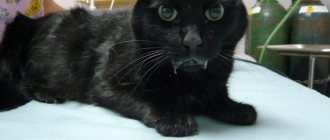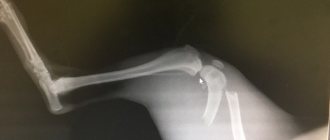Failure of a cat’s hind legs is most often provoked by serious illnesses or previous injuries that require immediate contact with a veterinary clinic. Even the slightest delay can lead to the death of the animal.
Gait disturbances, paralysis of the limbs and spinal injuries can only be cured by a specialist; it is impossible to relieve such conditions on your own. Failure to see a doctor in a timely manner increases the risk of complete loss of sensitivity and mobility of the paws. That is why, in order to avoid complications and return the animal to a confident gait, at the first manifestations of paralysis, you should take the animal to the veterinarian.
Failure of a cat's hind legs: causes of a dangerous condition
Impaired mobility of an animal's limbs can be caused by various reasons. It is very difficult for the owner to independently understand what caused the paralysis, so in this case it will not be possible to do without a trip to the veterinarian.
Failure of a cat's hind legs can be caused by:
- Spinal injuries. Limbs often lose mobility as a result of spinal column injuries. Trauma to the lumbar region especially often leads to such consequences. Animals with access to the outdoors are susceptible to similar injuries. They may be run over by a vehicle or fall from a height or jump awkwardly from a tree. Apartment pets also get injured when jumping from a closet or windowsill. Problems with the limbs are indicated by immobility of the hind legs, tail and general weakness.
- Thrombosis of the femoral arteries. Thromboembolism of the femoral arteries leads to loss of sensation in the limbs, which develops gradually. During its development, the animal experiences severe pain in the lower back, screams and behaves restlessly. If you do not show your pet to a doctor in a timely manner, tissue necrosis will begin and it will be impossible to restore the mobility of the hind legs. In addition, after a few days, thrombosis will lead to death.
- Tick bite. Tick bites, although rare, cause paralysis, leading to the death of the animal. After a tick bite, the animal becomes agitated, followed by weakness, apathy, trembling and paralysis. If action is not taken in time, death occurs.
- Inflammation of the spinal fluid. Myelitis develops against the background of infectious diseases, helminthic infestations, injuries and poisoning. The pathology is characterized by failure of the cat's hind legs, chaotic movements, elevated temperatures, upset stomach, diarrhea and urinary incontinence. Timely treatment will lead to relief of the disease and complete restoration of the mobility of the pet’s limbs.
- Hip dysplasia. With this pathology, bone formation is disrupted. The disease primarily affects large breed cats. The disease leads to the development of severe pain when walking and jumping. If the owner does not provide supportive treatment, this will lead to limb failure.
- Stroke. A cat's hind legs may also fail due to a stroke. The disease can affect both older and young animals as a result of poor nutrition or a sedentary lifestyle. When the cerebral vessels are blocked, paralysis of the limbs develops. Timely treatment, which should begin immediately after diagnosis, will help eliminate it.
- Heart failure. If the cardiovascular system does not work properly, the animal's limbs may fail. This occurs due to oxygen starvation, against the background of which muscle tissue atrophy develops. In addition, heart problems manifest themselves in shortness of breath, dry cough and lethargy.
Other pathologies also lead to loss of limb mobility, which can only be identified by a specialist after a complete examination of the sick cat.
Brain and spinal cord injuries
A cat's wobbly gait may indicate a serious injury to the head or back.
Spinal injuries are life-threatening to the animal, just like cranial injuries.
Veterinary experts report sad statistics among cats with spinal cord injuries. The animal most often remains disabled or dies immediately or after treatment.
Injuries to the brain and spinal cord occur when:
- falls from great heights;
- collision with a car;
- after unsuccessful jumps.
Owners of cats who jumped from a balcony or window often turn to veterinary hospitals. An animal can receive injuries, sometimes incompatible with life, in a collision with a stronger opponent - a dog. Damage to the spine is not uncommon when there is strong pressure from a powerful entrance door.
Symptoms characteristic of limb failure
Paresis of the limbs is represented by the following symptoms:
- complete or partial impairment of motor functions. The animal stops moving quickly, drags its paws or moves crawling;
- change in gait. If swaying and pulling up of the limbs is normal for a small kitten, then failure of the cat’s hind legs requires immediate intervention by a veterinarian;
- atrophy of the muscular system. The muscles of the hind limbs lose their elasticity;
- soreness when feeling the hind legs. The cat screams and struggles when the back of the body is probed;
- lack of sensitivity. The animal stops feeling cold and warmth with its paw pads.
If such symptoms appear, your pet should be taken to a veterinarian immediately.
Risk factors
There are several predisposing factors that can cause poor coordination and motor activity in a cat's hind legs. It is important to analyze them and understand what could have caused the deterioration in this case. This can facilitate diagnosis and prescribe the most appropriate treatment in a short time.
Among the common provoking factors are the following:
- Getting injured
. Very often, after an unsuccessful jump or fall, even from a small height, damage of varying severity can occur. Most people believe that cats can catch themselves in a split second when falling, but this is not always the case. The consequences of an injury can be visible immediately, or they can appear after a certain time, so you need to remember if similar incidents have happened recently.
- Breed predisposition
. Some cat breeds are at risk for certain diseases that can cause corresponding alarming symptoms. Hypoglycemia is considered a common problem for the Burmese breed. Chartreux and Maine Coons often have hip dysplasia, and Cymrics are considered a breed with congenital weakness in the hind legs. Such difficulties are the price to pay for artificially bred beauty and manipulation of genes carried out by breeders. - Inflammatory processes and infections
. They can affect any organ or organ system, but at different stages give complications in the form of impaired motor ability of the hind legs. In such cases, the fact that the cat walks poorly is not the only sign of illness. - Violation of metabolic processes
. Often, a deficiency of important vitamins leads to paralysis of the paws. The reason for this may be both metabolic disorders and improper nutrition of the animal.
First aid
If the owner notices a failure of the cat’s hind legs or problems with mobility, then before taking it to the veterinarian, he must provide first aid to the animal.
First you need to calm the pet and put it in a carrier or house. Then, if the hind paws are cold, you need to warm them up with a heating pad. After this, you need to immediately go to the veterinary clinic.
Main symptoms
Paralysis may have a pronounced or blurred clinical picture. As the disease progresses, symptoms will increase. At first, the owner may notice that the pet has become more lethargic, drowsy, moves uncertainly, and tries to crawl into a secluded corner where no one will bother him.
Sometimes he becomes aggressive if someone tries to pet him or pick him up.
It is difficult for a cat to keep his head in the usual state, swallow, lap, food falls out of his mouth, so his appetite, as a rule, decreases. He stops washing his face and looks unkempt. Such phenomena as hypersalivation, involuntary release of feces and urine become commonplace.
In case of injuries, thrombosis, hernias, the damaged limbs become cold, turn blue, and the pulse drops to a critical level.
With facial paralysis, asymmetry of the muzzle is observed: one of the corners of the mouth and eye goes down, blinking and movement of the facial muscles are absent. If the paralysis is bilateral, both corners of the mouth seem to slide down, causing the expression of the muzzle to become dull.
If you notice suspicious signs, you should immediately take the animal to the veterinary clinic. If help was provided to the animal at the initial stage, there is a chance of saving it.
How to treat paresis of the lower extremities?
After delivering the cat to the veterinarian, the specialist conducts an examination, determines the degree of sensitivity of the hind limbs, takes an X-ray and ultrasound, and also takes the tailed patient’s blood and urine for analysis.
Therapy is prescribed only after an accurate diagnosis has been made. It includes medication, physiotherapy, massage, and sometimes surgery.
Diagnostics
The earlier the diagnosis is started, the greater the chances of curing the animal without fatal consequences. Before scheduling an examination, the veterinarian will find out the following points:
- How long ago did the first symptoms appear?
- gradually or abruptly the animal stopped walking;
- whether the onset of the disorder was preceded by injury or illness.
For extensive diagnostics, the following tests and examinations are prescribed:
- neurological examination with determination of reflex conductivity;
- setting the sensitivity of the hind legs;
- X-ray of the spinal column;
- Ultrasound of the abdominal organs;
- general clinical urine and blood tests;
- MRI of the head and back.
Based on the data obtained, the specialist makes a diagnosis and determines why the cat is walking poorly. In rare cases, additional tests, such as bacteriological culture, are necessary.
Drug treatment
If paresis of the limbs is confirmed, appropriate drug therapy is selected for the cat. Depending on the disease that caused the paralysis, various drugs are used. They can be presented:
- antibiotics to relieve inflammation caused by infection;
- vitamins to strengthen the immune system;
- drugs that thin the blood for thrombosis and stroke;
- anti-mite drugs;
- diuretics.
The treatment regimen may differ depending on the underlying disease that caused the failure of the cat's hind legs.
Oncological diseases
Ataxia or an unsteady gait in a pet may indicate the development of malignant or benign tumors in the ear canal, spinal cord or brain.
Nerve endings that are compressed as the tumor grows and develops cannot function normally. This leads to various disorders, including impaired coordination of movements, paresis and paralysis.
Due to the large flow of incoming questions, free veterinary consultations are temporarily suspended.
Physiotherapy
Recovery from limb paresis is very long and requires mandatory physiotherapeutic procedures.
To help your pet recover faster, veterinarians advise performing a number of exercises that will help restore neurological functions:
- Bike. To perform this exercise, the animal must be placed on its back and alternately perform circular movements with its hind legs for five minutes, simulating riding a bicycle.
- Paw massage. Every day, the owner must knead the cat’s paw pads and the paralyzed limbs themselves.
- Carding. A sick pet needs to be scratched in different places on the body. Progress will become noticeable when the cat, after the next “scratching”, begins to try to scratch itself with its hind paw.
- Rolling on the ball. To do this, take the cat and place it with its stomach on the ball, making sure that its limbs slightly touch the floor. In this position, the animal must be slowly rolled back and forth, holding it by the back.
- Support. You need to pass a wide strip of fabric under your pet's belly and walk with it around the room, holding the ends of the fabric.
- Moving the hind legs. To perform this exercise, you need to grab the animal by the hind legs and slowly move them, imitating walking.
- Swimming in the bathtub. This exercise is suitable for those cats who are not afraid of water. To perform this, the animal must be forced to swim in the bathtub every day, supported under the stomach and head so that it does not swallow water.
"Important! To speed up recovery, after a cat’s hind legs fail, it is necessary to work with it daily, devoting at least an hour a day to physical therapy.”
What are the consequences of failure of a cat's hind legs?
Failure of a cat's hind legs is a complex ailment that requires immediate treatment at a veterinary clinic. Self-medication of paresis is completely excluded, since it will not give any results and will only worsen the animal’s condition.
In the absence of proper drug treatment, paresis of the limbs can cause death, which will occur within a few days and will be extremely painful for the pet.
Intoxication
Impaired coordination of movements in a pet may indicate toxic substances entering the body.
As a result of intoxication, which occurs instantly or acutely, neurological symptoms increase.
Signs of poisoning will directly depend on the factors that provoked the intoxication. The main causes of poisoning in cats are:
- low-quality, expired feed or other food, as well as contaminated water;
- penetration through the respiratory tract of chemical vapors, which are absorbed into tissues at high speed;
- a cat eating poisonous plants or an animal being bitten by insects, snakes or spiders.
A shaky, uncertain gait is observed in cats during the recovery period after anesthesia. This phenomenon can also be attributed to intoxication, since narcotic substances negatively affect the functioning of the body, albeit in a weak form.
One of the most common causes of poisoning in pets is food. Poisons enter the body in the form of household chemicals, paints, herbicides or fertilizers. Poisoning and impaired coordination of movements against this background often occur due to the negligence of the owner, who insecurely hid medications from the pet.









